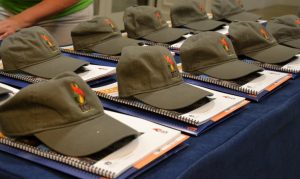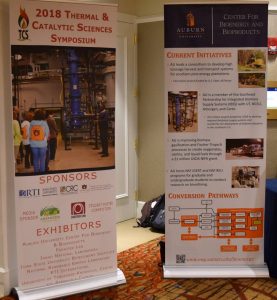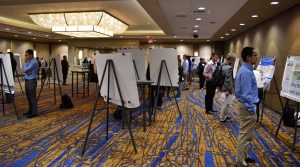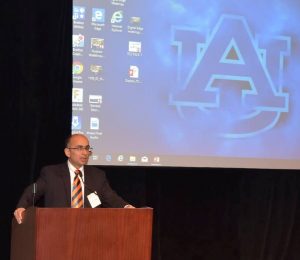by Leyla Battista-Channell* (Advanced Biofuels USA) Auburn, Alabama: Home to the Auburn tigers, the “loveliest village on the plains,” and this year’s host to the Thermochemical Sciences Symposium. Previously held at other universities, why Auburn University this year? The Biosystems Engineering department at Auburn University has been on the rise in the past years, steadily adding new research ventures relating to biomass conversion and pyrolysis. Dr. Sushil Adhikari, a professor in the department conducting thermochemical and biofuels related research, was acting conference chairperson and coordinator for this year’s event.
The conference can be described as diverse, technical, dynamic, and academically focused. The event was divided into two and a half days with lectures, technical sessions, and poster presentations held each day. There were four main focus areas for the conference: lignin, biomass, pyrolysis, and waste utilization.
Lignin and Biomass Utilization
The first day of the conference introduced biomass as a topic by first examining some challenges faced by biorefiners. A major hurdle for biorefiners is the unpredictability surrounding various feedstocks. Currently, there are three main screening methods available. Char measurement is the most rapid of the three, compositional analysis of biomass is more defined but takes longer, and high throughput Py-MBMS to gauge pyrolysis vapor speciation.
The National Renewable Energy Laboratory presented a new study being conducted to tackle this hurdle. The experiment studies 20 different feedstocks in an effort to accelerate screening methods and better anticipate how the treatment processes will be affected.
The plenary sessions started off day two by discussing the fundamentals of lignin and biomass as well as challenges and possibilities for their exploitation.
Lignin
Lignin is one of the most abundant biobased materials in nature. It is also one of the most challenging materials to understand and define. In short, lignin is the part of the plant that gives structure and the component in wood that makes the material hard. Its properties make it ideal for its conventional uses in construction or furniture making. As for its behavior in thermochemical processing, the higher the lignin content of feedstock, the higher the temperatures needed to yield more heavy oils and biochar. The plenary sessions for day two assessed some of the basic procedural outcomes of lignin processing.
Commercial use of lignin is still a challenge due to its mysterious nature, but if utilized correctly, could revolutionize the biofuels and bioenergy industries.
Although optimistic about the future of pyrolysis, the speakers did not attempt to ignore the challenges faced. For instance, difficulties introducing biocrude into refiners, thermal instability, high level of impurities, high acidity, and immiscibility in fossil fuels.
Technical Sessions
With this shared background knowledge, there were many shared goals amongst the researchers; such as improving feed/product characterization and upgrading biocrude refinery integration. After reviewing fundamentals, challenges, and possibilities with all conference attendees, the technical sessions commenced.
Torrefaction
Torrefaction was the topic of conversation for the first technical session on day two. The University of Guelph in Canada is currently studying torrefaction and biomass. Multiple types of biomass and waste are being studied in their experiment: woody biomass, construction waste, agricultural biomass, wet biomass, and purpose grown biomass. The study found that hydrothermal carbonization of fruit wastes resulted in improved fuel quality and higher mass yields due to the higher levels of glucose. While the study did have a positive outcome, the research team concluded that the process would not be competitive on its own.
Guayule and Guar
Characterization and conversion of guayule and guar bagasse was the next topic covered by a research team from New Mexico State University. Guar and guayule are the most prevalent forms of biomass used in the southwestern region of the United States.
Guayule is a highly resilient perennial that has rubber properties. Once processed, guayule biomass yields resin for asphalt, bagasse (used in wood pellets), and a hard rubber that can then be used in tires. Its high lignin content limits access of enzymes to the cellulose, resulting in low alcohol yield.
Similar in its growth requirements, guar thrives in the arid climate of New Mexico. Guar is used to make gaur gum (food additive), animal feed, and as a soil amendment. Both plants are popular forms of biomass for their resiliency and low water requirements. However, further identification and characterization of the plants and their co-products will be needed to make the guar/guayule market viable.
By-products/Co-Products
It is important to note that in the biomass conversion process, there are a number of by-products. To ignore the potential of by-products to also be converted into useful end-products would be an incredible misstep for the scientific community.
The TCS conference speakers did not shy away from this topic. A number of speakers made an effort to consider uses for by-products and were very open to new research undertakings dealing solely in applications of by-products.
In the case of woody biomass, black liquor is a by-product. The University of Zaragoza in Spain is currently experimenting with hydrothermal treatment of black liquor. The outcome of their studying produced a substance capable of being used in the biodiesel production and blending process.
The by-products also move beyond applications in biofuels alone. Guar and guayule by-products are being considered as possible bio-based additives in the cosmeceuticals industry.
Please note that the various projects outlined in the preceding paragraphs only just begin to highlight the incredible work being done by the individuals in attendance. A comprehensive list of speakers and poster presentations may be found at the end of this article.
Pyrolysis
Pyrolysis is a thermochemical process that exposes carbon-based matter to high temperatures in the absence of oxygen. The process ultimately yields high energy content products in the following forms: solid, liquid by-product, and a non-condensable gas.
The conference kicked off with a lecture about the current state of the pyrolysis industry with Art Ragauskas from the University of Tennessee.
Long overlooked due to its perceived youth, pyrolysis is finally coming to be a mature industry. With the ability to now be directly integrated into existing refineries at the front end of the process, pyrolysis could become one of the cheapest options for producing biofuels.
Throughout the first plenary session, a consistent theme was evident: the potential for pyrolysis and all of its various products is infinite.
Technical Sessions
The first technical session concentrated on improving products through advancements in fast pyrolysis and modeling. In fast pyrolysis, organic matter is decomposed in the absence of oxygen at 450-600 centigrade to produce biochar, non-condensable gas, and bio-oil. While not generally required, hydrotreating is used to compensate for the various limitations accompanying fast pyrolysis.
Advanced hydrogen assisted pyrolysis, or hydrous pyrolysis, may effectively address these limitations and produce refinery ready biocrude.
Micro-kinetic modeling was then discussed as a computational method to significantly advance lignin utilization. Kinetic modeling, specifically with regards to autothermal pyrolysis, further offered improved heat transfer for better scalability.
Waste as a Resource
Billions of tons of municipal solid wastes are either sent to landfills or incinerated. MSW, while currently considered a burdensome waste stream, could also be considered a resource for power generation and new jobs.
Unfortunately, this MSW resource is not being utilized well. Since MSW is always changing, technology cannot be particular, making gasification a viable option.
Dr. Ajay Kumar, from Oklahoma State University, presented research findings for his mobile scale power generation with MSW and switchgrass experiment. The goal of the project was to mix MSW and switchgrass and feed the product into a gasifier to produce electrical power and reduce exhaust emissions. The second goal of the project was to fit all of the equipment into the size of a shipping container for greater mobility. Dr. Kumar and his team successfully produced electricity and determined the maximum MSW blend to be 40%.
MSW is not the only under-utilized resource. Food waste is a widespread issue. 45,000 tons of eggshells are disposed of each year in Canada alone. This equates to 40,000 tons of CaCO3 being wasted. Dr. Animesh Dutta proposed a new outlet for eggshells as a sorbent in chemical looping gasification to enhance carbon negativity.
 Not all serious work, some fun handouts for TCS attendees, too. Conference volunteers prepare to greet attendees at the welcome table.
Not all serious work, some fun handouts for TCS attendees, too. Conference volunteers prepare to greet attendees at the welcome table.
Conference Summary
While most other technically advanced conferences aim to establish a kind of intellectual exclusivity and formality, the TCS conference deviates from this. The TCS conference somehow managed to maintain a level of advanced technicality while also fostering easy and relaxed dialogue among its attendees.
The TCS conference provides an excellent platform for students, researchers, professors, and companies to come together and discuss interconnected scientific advancements in a welcoming environment.
In addition to the technical sessions, this year’s TCS agenda also included a variety of leisure activities meant to showcase the “local color” in Auburn. Attendees were treated to a reception dinner on the first evening of the event. After the last technical session on day two, an Auburn University wildlife team put on a raptor show for guests. Immediately following the raptor show, a banquet and award ceremony was held at the Auburn Hotel.
After the close of the conference, attendees were also invited on a tour of the gasification and gas-to-liquid laboratory. For those seeking a more intimate and technical conference with a comfortable milieu, look no further than the TCS conference!
*Leyla Battista has a Bachelor’s degree in Biosystems Engineering from Auburn University. She is currently a Master’s candidate in Environmental Sciences at Emory University. For more information on her current and past projects visit her online portfolio at lmb00432.wixsite.com/eportfolio.
Photos by: Ms. Joy Brown and Ms. Amber Denham.
Center for Bioenergy and Bioproducts (Auburn University)
Nearly 55,000 articles in our online library!
Use the categories and tags listed below to access the nearly 50,000 articles indexed on this website.
Advanced Biofuels USA Policy Statements and Handouts!
- For Kids: Carbon Cycle Puzzle Page
- Why Ethanol? Why E85?
- Just A Minute 3-5 Minute Educational Videos
- 30/30 Online Presentations
- “Disappearing” Carbon Tax for Non-Renewable Fuels
- What’s the Difference between Biodiesel and Renewable (Green) Diesel? 2020 revision
- How to De-Fossilize Your Fleet: Suggestions for Fleet Managers Working on Sustainability Programs
- New Engine Technologies Could Produce Similar Mileage for All Ethanol Fuel Mixtures
- Action Plan for a Sustainable Advanced Biofuel Economy
- The Interaction of the Clean Air Act, California’s CAA Waiver, Corporate Average Fuel Economy Standards, Renewable Fuel Standards and California’s Low Carbon Fuel Standard
- Latest Data on Fuel Mileage and GHG Benefits of E30
- What Can I Do?
Donate
DonateARCHIVES
- December 2025
- November 2025
- October 2025
- September 2025
- August 2025
- July 2025
- June 2025
- May 2025
- April 2025
- March 2025
- February 2025
- January 2025
- December 2024
- November 2024
- October 2024
- September 2024
- August 2024
- July 2024
- June 2024
- May 2024
- April 2024
- March 2024
- February 2024
- January 2024
- December 2023
- November 2023
- October 2023
- September 2023
- August 2023
- July 2023
- June 2023
- May 2023
- April 2023
- March 2023
- February 2023
- January 2023
- December 2022
- November 2022
- October 2022
- September 2022
- August 2022
- July 2022
- June 2022
- May 2022
- April 2022
- March 2022
- February 2022
- January 2022
- December 2021
- November 2021
- October 2021
- September 2021
- August 2021
- July 2021
- June 2021
- May 2021
- April 2021
- March 2021
- February 2021
- January 2021
- December 2020
- November 2020
- October 2020
- September 2020
- August 2020
- July 2020
- June 2020
- May 2020
- April 2020
- March 2020
- February 2020
- January 2020
- December 2019
- November 2019
- October 2019
- September 2019
- August 2019
- July 2019
- June 2019
- May 2019
- April 2019
- March 2019
- February 2019
- January 2019
- December 2018
- November 2018
- October 2018
- September 2018
- August 2018
- July 2018
- June 2018
- May 2018
- April 2018
- March 2018
- February 2018
- January 2018
- December 2017
- November 2017
- October 2017
- September 2017
- August 2017
- July 2017
- June 2017
- May 2017
- April 2017
- March 2017
- February 2017
- January 2017
- December 2016
- November 2016
- October 2016
- September 2016
- August 2016
- July 2016
- June 2016
- May 2016
- April 2016
- March 2016
- February 2016
- January 2016
- December 2015
- November 2015
- October 2015
- September 2015
- August 2015
- July 2015
- June 2015
- May 2015
- April 2015
- March 2015
- February 2015
- January 2015
- December 2014
- November 2014
- October 2014
- September 2014
- August 2014
- July 2014
- June 2014
- May 2014
- April 2014
- March 2014
- February 2014
- January 2014
- December 2013
- November 2013
- October 2013
- September 2013
- August 2013
- July 2013
- June 2013
- May 2013
- April 2013
- March 2013
- February 2013
- January 2013
- December 2012
- November 2012
- October 2012
- September 2012
- August 2012
- July 2012
- June 2012
- May 2012
- April 2012
- March 2012
- February 2012
- January 2012
- December 2011
- November 2011
- October 2011
- September 2011
- August 2011
- July 2011
- June 2011
- May 2011
- April 2011
- March 2011
- February 2011
- January 2011
- December 2010
- November 2010
- October 2010
- September 2010
- August 2010
- July 2010
- June 2010
- May 2010
- April 2010
- March 2010
- February 2010
- January 2010
- December 2009
- November 2009
- October 2009
- September 2009
- August 2009
- July 2009
- June 2009
- May 2009
- April 2009
- March 2009
- February 2009
- January 2009
- December 2008
- November 2008
- October 2008
- September 2008
- August 2008
- July 2008
- June 2008
- May 2008
- April 2008
- March 2008
- February 2008
- January 2008
- December 2007
- November 2007
- October 2007
- September 2007
- August 2007
- June 2007
- February 2007
- January 2007
- October 2006
- April 2006
- January 2006
- April 2005
- December 2004
- November 2004
- December 1987
CATEGORIES
- About Us
- Advanced Biofuels Call to Action
- Aviation Fuel/Sustainable Aviation Fuel (SAF)
- BioChemicals/Renewable Chemicals
- BioRefineries/Renewable Fuel Production
- Business News/Analysis
- Cooking Fuel
- Education
- 30/30 Online Presentations
- Competitions, Contests
- Earth Day 2021
- Earth Day 2022
- Earth Day 2023
- Earth Day 2024
- Earth Day 2025
- Executive Training
- Featured Study Programs
- Instagram TikTok Short Videos
- Internships
- Just a Minute
- K-12 Activities
- Mechanics training
- Online Courses
- Podcasts
- Scholarships/Fellowships
- Teacher Resources
- Technical Training
- Technician Training
- University/College Programs
- Events
- Coming Events
- Completed Events
- More Coming Events
- Requests for Speakers, Presentations, Posters
- Requests for Speakers, Presentations, Posters Completed
- Webinars/Online
- Webinars/Online Completed; often available on-demand
- Federal Agency/Executive Branch
- Agency for International Development (USAID)
- Agriculture (USDA)
- Commerce Department
- Commodity Futures Trading Commission
- Congressional Budget Office
- Defense (DOD)
- Air Force
- Army
- DARPA (Defense Advance Research Projects Agency)
- Defense Logistics Agency
- Marines
- Navy
- Education Department
- Energy (DOE)
- Environmental Protection Agency
- Federal Energy Regulatory Commission (FERC)
- Federal Reserve System
- Federal Trade Commission
- Food and Drug Administration
- General Services Administration
- Government Accountability Office (GAO)
- Health and Human Services (HHS)
- Homeland Security
- Housing and Urban Development (HUD)
- Interior Department
- International Trade Commission
- Joint Office of Energy and Transportation
- Justice (DOJ)
- Labor Department
- National Academies of Sciences Engineering Medicine
- National Aeronautics and Space Administration
- National Oceanic and Atmospheric Administration
- National Research Council
- National Science Foundation
- National Transportation Safety Board (NTSB)
- Occupational Safety and Health Administration
- Overseas Private Investment Corporation
- Patent and Trademark Office
- Securities and Exchange Commission
- State Department
- Surface Transportation Board
- Transportation (DOT)
- Federal Aviation Administration
- National Highway Traffic Safety Administration (NHTSA)
- Pipeline and Hazardous Materials Safety Admin (PHMSA)
- Treasury Department
- U.S. Trade Representative (USTR)
- White House
- Federal Legislation
- Federal Litigation
- Federal Regulation
- Feedstocks
- Agriculture/Food Processing Residues nonfield crop
- Alcohol/Ethanol/Isobutanol
- Algae/Other Aquatic Organisms/Seaweed
- Atmosphere
- Carbon Dioxide (CO2)
- Field/Orchard/Plantation Crops/Residues
- Forestry/Wood/Residues/Waste
- hydrogen
- Manure
- Methane/Biogas
- methanol/bio-/renewable methanol
- Not Agriculture
- RFNBO (Renewable Fuels of Non-Biological Origin)
- Seawater
- Sugars
- water
- Funding/Financing/Investing
- grants
- Green Jobs
- Green Racing
- Health Concerns/Benefits
- Heating Oil/Fuel
- History of Advanced Biofuels
- Infrastructure
- Aggregation
- Biofuels Engine Design
- Biorefinery/Fuel Production Infrastructure
- Carbon Capture/Storage/Use
- certification
- Deliver Dispense
- Farming/Growing
- Precursors/Biointermediates
- Preprocessing
- Pretreatment
- Terminals Transport Pipelines
- International
- Abu Dhabi
- Afghanistan
- Africa
- Albania
- Algeria
- Angola
- Antarctica
- Arctic
- Argentina
- Armenia
- Aruba
- Asia
- Asia Pacific
- Australia
- Austria
- Azerbaijan
- Bahamas
- Bahrain
- Bangladesh
- Barbados
- Belarus
- Belgium
- Belize
- Benin
- Bermuda
- Bhutan
- Bolivia
- Bosnia and Herzegovina
- Botswana
- Brazil
- Brunei
- Bulgaria
- Burkina Faso
- Burundi
- Cambodia
- Cameroon
- Canada
- Caribbean
- Central African Republic
- Central America
- Chad
- Chile
- China
- Colombia
- Congo
- Congo, Democratic Republic of
- Costa Rica
- Croatia
- Cuba
- Cyprus
- Czech Republic
- Denmark
- Dominican Republic
- Dubai
- Ecuador
- Egypt
- El Salvador
- Equatorial Guinea
- Estonia
- Eswatini/Swaziland
- Ethiopia
- European Union (EU)
- Fiji
- Finland
- France
- French Guiana
- Gabon
- Georgia
- Germany
- Ghana
- Global South
- Greece
- Greenland
- Grenada
- Guatemala
- Guinea
- Guyana
- Haiti
- Honduras
- Hong Kong
- Hungary
- Iceland
- India
- Indonesia
- Iran
- Iraq
- Ireland
- Israel
- Italy
- Ivory Coast
- Jamaica
- Japan
- Jersey
- Jordan
- Kazakhstan
- Kenya
- Korea
- Kosovo
- Kuwait
- Laos
- Latin America
- Latvia
- Lebanon
- Liberia
- Lithuania
- Luxembourg
- Macedonia
- Madagascar
- Malawi
- Malaysia
- Maldives
- Mali
- Malta
- Marshall Islands
- Mauritania
- Mauritius
- Mexico
- Middle East
- Moldova
- Monaco
- Mongolia
- Morocco
- Mozambique
- Myanmar/Burma
- Namibia
- Nepal
- Netherlands
- New Guinea
- New Zealand
- Nicaragua
- Niger
- Nigeria
- North Africa
- North America
- North Korea
- Northern Ireland
- Norway
- Oman
- Pakistan
- Panama
- Papua New Guinea
- Paraguay
- Peru
- Philippines
- Poland
- Portugal
- Qatar
- Republic of
- Romania
- Russia
- Rwanda
- Saudi Arabia
- Scotland
- Senegal
- Serbia
- Sierra Leone
- Singapore
- Slovakia/Slovak Republic
- Slovenia
- Solomon Islands
- South Africa
- South America
- South Korea
- South Sudan
- Southeast Asia
- Spain
- Sri Lanka
- Sudan
- Suriname
- Sweden
- Switzerland
- Taiwan
- Tanzania
- Thailand
- Timor-Leste
- Togo
- Trinidad and Tobago
- Tunisia
- Turkey
- Uganda
- UK (United Kingdom)
- Ukraine
- United Arab Emirates UAE
- Uruguay
- Uzbekistan
- Vatican
- Venezuela
- Vietnam
- Wales
- Zambia
- Zanzibar
- Zimbabwe
- Marine/Boat Bio and Renewable Fuel/MGO/MDO/SMF
- Marketing/Market Forces and Sales
- Opinions
- Organizations
- Original Writing, Opinions Advanced Biofuels USA
- Policy
- Presentations
- Biofuels Digest Conferences
- DOE Conferences
- Bioeconomy 2017
- Bioenergy2015
- Biomass2008
- Biomass2009
- Biomass2010
- Biomass2011
- Biomass2012
- Biomass2013
- Biomass2014
- DOE Project Peer Review
- Other Conferences/Events
- R & D Focus
- Carbon Capture/Storage/Use
- Co-Products
- Feedstock
- Logistics
- Performance
- Process
- Vehicle/Engine/Motor/Aircraft/Boiler/Ship
- Yeast
- Railroad/Train/Locomotive Fuel
- Resources
- Books Web Sites etc
- Business
- Definition of Advanced Biofuels
- Find Stuff
- Government Resources
- Scientific Resources
- Technical Resources
- Tools/Decision-Making
- Rocket/Missile Fuel
- Sponsors
- States
- Alabama
- Alaska
- Arizona
- Arkansas
- California
- Colorado
- Connecticut
- Delaware
- Florida
- Georgia
- Hawai'i
- Idaho
- Illinois
- Indiana
- Iowa
- Kansas
- Kentucky
- Louisiana
- Maine
- Maryland
- Massachusetts
- Michigan
- Midwest
- Minnesota
- Mississippi
- Missouri
- Montana
- Native American tribal nation lands
- Nebraska
- Nevada
- New Hampshire
- New Jersey
- New Mexico
- New York
- North Carolina
- North Dakota
- Ohio
- Oklahoma
- Oregon
- Pennsylvania
- Puerto Rico
- Rhode Island
- South Carolina
- South Dakota
- Tennessee
- Texas
- Utah
- Vermont
- Virginia
- Washington
- Washington DC
- West Coast
- West Virginia
- Wisconsin
- Wyoming
- Sustainability
- Uncategorized
- What You Can Do
tags
© 2008-2023 Copyright Advanced BioFuels USA. All Rights reserved.



.jpg)





Comments are closed.